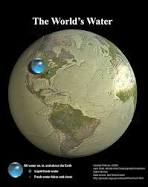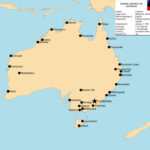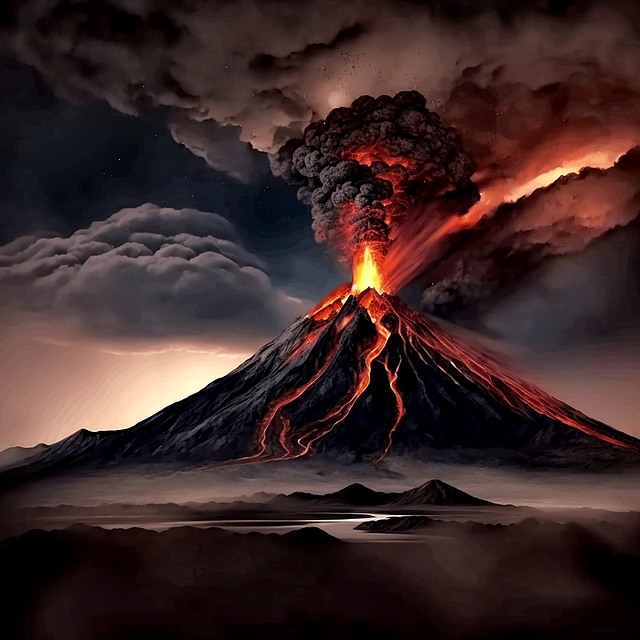why does Earth have 70% water?

Have you ever gazed out at the vast expanse of the ocean and asked the question: why does Earth have 70% water? This is a common misconception because when compared with the mass of the earth, it is surprisingly small. Water is 2 parts hydrogen to 1 part oxygen and about 70% of the earth is covered by water, but not 70% of it.
The Earth’s abundant water is not just a coincidence; it is a fundamental element that has shaped the planet’s very existence.
From the depths of the oceans to the clouds in the sky, water is everywhere on Earth, playing a crucial role in sustaining life as we know it.
The story of Earth’s watery abundance is a tale of cosmic origins, geological processes, and biological evolution.
It is a story of ancient oceans and primordial seas, of comets and asteroids delivering water to a young planet, and of the intricate dance of the water cycle that sustains life today.
This article aims to uncover the secrets of Earth’s watery realm and discover the profound impact that water has had on the planet’s history and future. Piquing Curiosity: The Mystery of Earth’s Water Dominance
Water on the earth, water in the earth
Liquid water covers more than 70% of the earth’s surface, of which about 95.6% is in the ocean, and the remaining 4% is in glaciers, ice sheets, groundwater, lakes, rivers, soil moisture, and the atmosphere.
But most of the earth’s water is deep underground: the mantle contains one to ten times the volume of the ocean.
On the surface of the earth, “water” means that there are two hydrogens per oxygen (H20), and what we call “water” in the mantle corresponds to the hydrogen incorporated in minerals, magma, and fluids. This hydrogen can bond with the surrounding oxygen to form water under appropriate temperature and pressure conditions.
Although water accounts for less than 0.5% of the earth’s mass, it is the key to the evolution of the earth itself and life on its surface.
In the early solar system, there was a large amount of hydrogen, mainly in the form of dihydrogen gas (H2), or bonded to oxygen atoms to form water (H2O). However, the Earth and other rocky planets (Mercury, Venus, and Mars) form near the sun, where it is too hot for water to blend into the rocks as ice: it just evaporates. So, why does the Earth now have so much water in both the mantle and the surface?
Approximately 71% of the earth’s surface is covered with oceans, that is, saline sea water or ice floes. About 3% of the earth’s land is covered by some fresh water, and about 10% is covered by freshwater ice, including snow, glaciers, and Antarctic ice Under the land ice is land soil, soil, gravel, and/or bedrock.
It is the same under all bodies of fresh water, usually under a thick layer of silt. Most of the earth’s deep-sea floor is covered by two types of gelatinous ooze, siliceous or calcareous, made from the debris of dead sea creatures. Most of these creatures are tiny plankton, but they are also larger forms.
When conditions permit, mainly in deep places, after all other organic matter is decomposed and recovered, these exudates still exist and can undergo diagenesis, in which they are compacted and cemented to form sedimentary rocks.
This same process, mainly in ancient times with different conditions, trapped organic molecules in the formation of rocks, which later became today’s petroleum deposits. This is still happening today, but because today’s ocean conditions are very different, the speed is much lower.
The Importance of Water
Lifeblood of the Planet: Water’s Crucial Role
Water is not just a mere substance; it is the lifeblood of our planet, essential for sustaining all forms of life and driving the intricate ecosystems that flourish on Earth.
Water’s Unique Properties: Exploring Its Exceptional Characteristics
Beyond its ubiquity, water possesses a myriad of unique properties, from its ability to dissolve various substances to its unmatched capacity to moderate temperature changes.
The Human Connection: Water’s Significance for Life on Earth
For humanity, water holds profound significance, serving as a vital resource for agriculture, industry, and daily sustenance, shaping civilizations and cultures throughout history.
Formation of Earth’s Oceans
Ancient Origins: Tracing the Origins of Earth’s Oceans
The genesis of Earth’s oceans traces back to the planet’s tumultuous early years when volcanic activity and asteroid bombardment sculpted its primordial landscape.
The Primordial Soup: Understanding the Early Earth’s Composition
In the chaotic aftermath of its formation, Earth was enveloped in a dense atmosphere of gases and vapors, creating a primordial soup from which its oceans would eventually emerge.
Water’s Cosmic Journey: The Role of Comets, Asteroids, and Volcanoes
The delivery of water to Earth was a cosmic affair, with icy comets, water-rich asteroids, and volcanic outgassing contributing to the accumulation of water on the planet’s surface.
The Water Cycle
The Never-Ending Dance: An Overview of the Water Cycle
The water cycle, a perpetual dance of evaporation, condensation, and precipitation, orchestrates the movement of water across Earth’s atmosphere, land, and oceans.
Evaporation: From Liquid to Vapor
Under the sun’s warming rays, water evaporates from the Earth’s surface, rising into the atmosphere as invisible vapor, fueling the atmospheric engine that drives weather patterns.
Condensation: Cloud Formation and Precipitation
As water vapor cools and condenses, it forms clouds, where tiny droplets coalesce and eventually fall to Earth as rain, snow, or hail, replenishing the planet’s water reservoirs.
The Role of Oceans, Rivers, and Lakes: Navigating the Pathways of Water
Earth’s waterways, from expansive oceans to meandering rivers and tranquil lakes, serve as vital conduits for the circulation and distribution of water across the planet’s surface.
The Role of Plate Tectonics
Earth’s Dynamic Crust: An Introduction to Plate Tectonics
Plate tectonics, the driving force behind Earth’s geological activity, plays a pivotal role in shaping the distribution and movement of water through processes such as subduction and seafloor spreading.
Subduction Zones: The Subterranean Movement of Water
At subduction zones, oceanic plates dive beneath continental plates, carrying water deep into the Earth’s mantle, where it influences geological processes and fuels volcanic activity.
Seafloor Spreading: Birthplaces of New Oceanic Crust
Seafloor spreading occurs along mid-ocean ridges, where magma rises from the mantle to create new oceanic crust, perpetuating the cycle of ocean formation and renewal.
Climate Regulation
Earth’s Thermostat: How Water Regulates Climate
Water exerts a profound influence on Earth’s climate, acting as a thermostat that regulates temperature extremes and moderates the planet’s overall climate stability.
Ocean Currents: The Engine of Global Climate
Ocean currents, driven by wind, temperature, and salinity gradients, circulate heat around the globe, shaping regional climates and influencing weather patterns.
The Albedo Effect: Water’s Reflective Power
Water’s reflective properties, known as the albedo effect, play a crucial role in regulating Earth’s energy balance, affecting cloud formation, surface temperatures, and climate feedback loops.
The Impact of Life on Earth’s Water
From Single-Celled Organisms to Complex Life Forms: Evolutionary Impacts on Water
Life has profoundly influenced Earth’s water cycle, from the earliest photosynthetic microbes that oxygenated the atmosphere to modern ecosystems that regulate nutrient cycling and carbon storage.
The Great Oxygenation Event: Altering Earth’s Atmosphere Through Photosynthesis
The Great Oxygenation Event, precipitated by the emergence of photosynthetic bacteria, transformed Earth’s atmosphere, paving the way for the evolution of complex life forms and reshaping global biogeochemical cycles.
The Balance of Water on Earth
The Goldilocks Zone: Earth’s Ideal Distance from the Sun
Earth’s position within the habitable zone of the solar system, known as the Goldilocks zone, ensures that water exists in a stable liquid state, essential for supporting life as we know it.
Ice Ages and Interglacials: Understanding Earth’s Climate Cycles
Throughout Earth’s history, cyclical fluctuations in climate, known as ice ages and interglacials, have influenced the distribution of water, shaping landscapes and ecosystems on a global scale.
Human Influence on Earth’s Water
The Water Footprint: Humanity’s Impact on Global Water Resources
Human activities, from agriculture and industry to urbanization and deforestation, have exerted a profound impact on Earth’s water resources, altering natural hydrological processes and depleting freshwater reserves.
Pollution and Contamination: Threats to Water Quality
Water pollution, caused by industrial discharge, agricultural runoff, and urban waste, poses significant threats to water quality, endangering aquatic ecosystems and human health alike.
Water Scarcity: Challenges and Solutions for the Future
Water scarcity, exacerbated by population growth, climate change, and inefficient water management practices, presents one of the greatest challenges of the 21st century, demanding innovative solutions and collective action to ensure water security for future generations.
The Search for Extraterrestrial Water
Exploring Other Worlds: The Hunt for Water Beyond Earth
The quest for extraterrestrial water extends beyond Earth, as scientists explore distant planets, moons, and asteroids in search of clues to the origins and distribution of water in the cosmos.
Mars: Traces of a Watery Past
Mars, once a wet and habitable world, preserves tantalizing evidence of ancient lakes, rivers, and oceans, raising questions about the fate of its water and the possibility of past life.
Exoplanets and Habitability: Water’s Role in the Search for Life Beyond Earth
Exoplanets, orbiting distant stars, offer tantalizing prospects for discovering water and potentially habitable environments, igniting the imagination and driving efforts to explore the cosmic ocean of possibilities.
Conclusion
As we reflect on Earth’s watery mysteries, we are reminded of the profound interconnectedness of water with life, climate, and planetary evolution, inspiring awe and wonder at the dynamic processes that shape our world.
Looking ahead, the preservation of Earth’s precious water resources is paramount, requiring global cooperation, sustainable practices, and a commitment to stewardship to ensure a thriving and resilient planet for generations to come.









